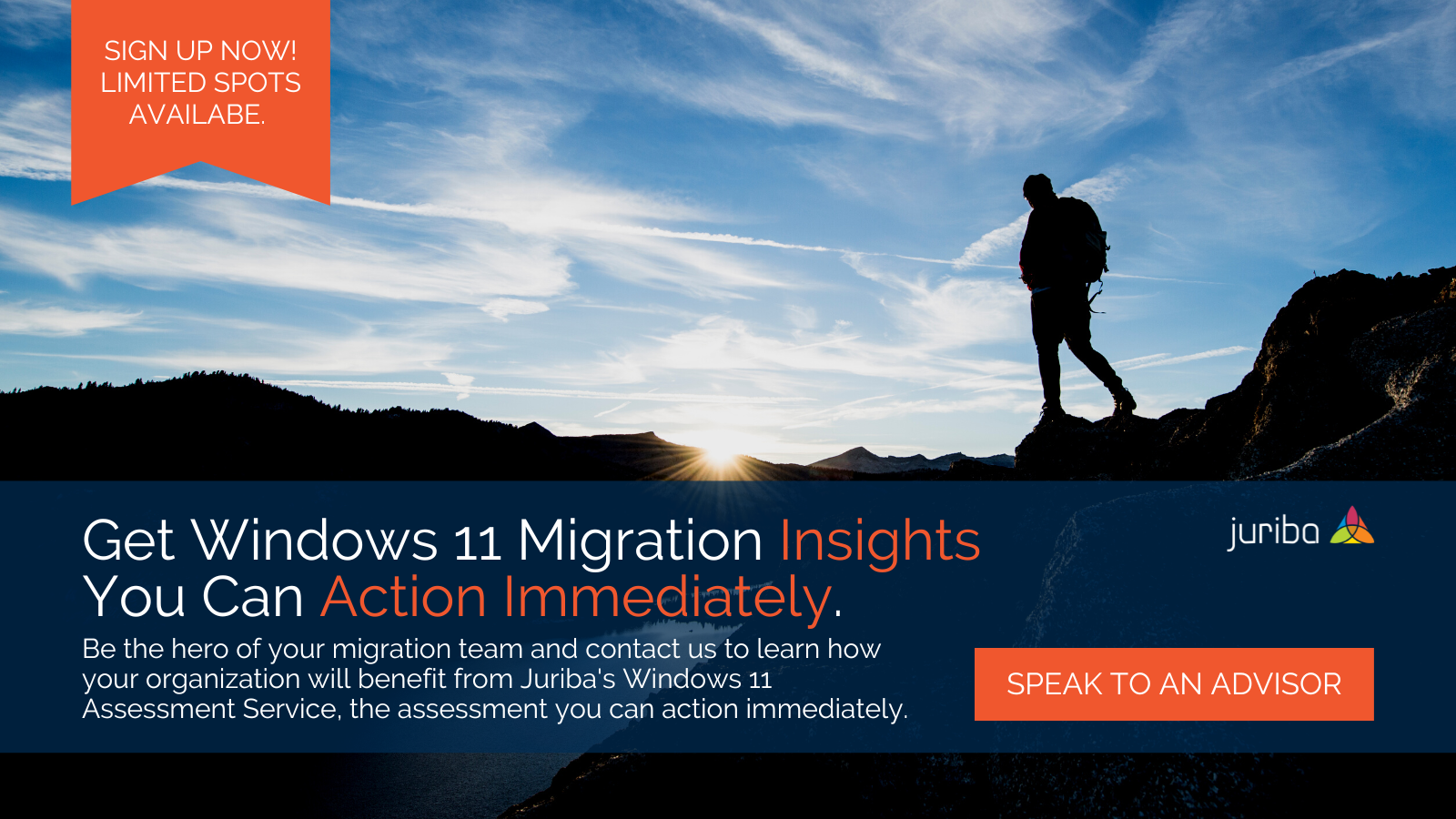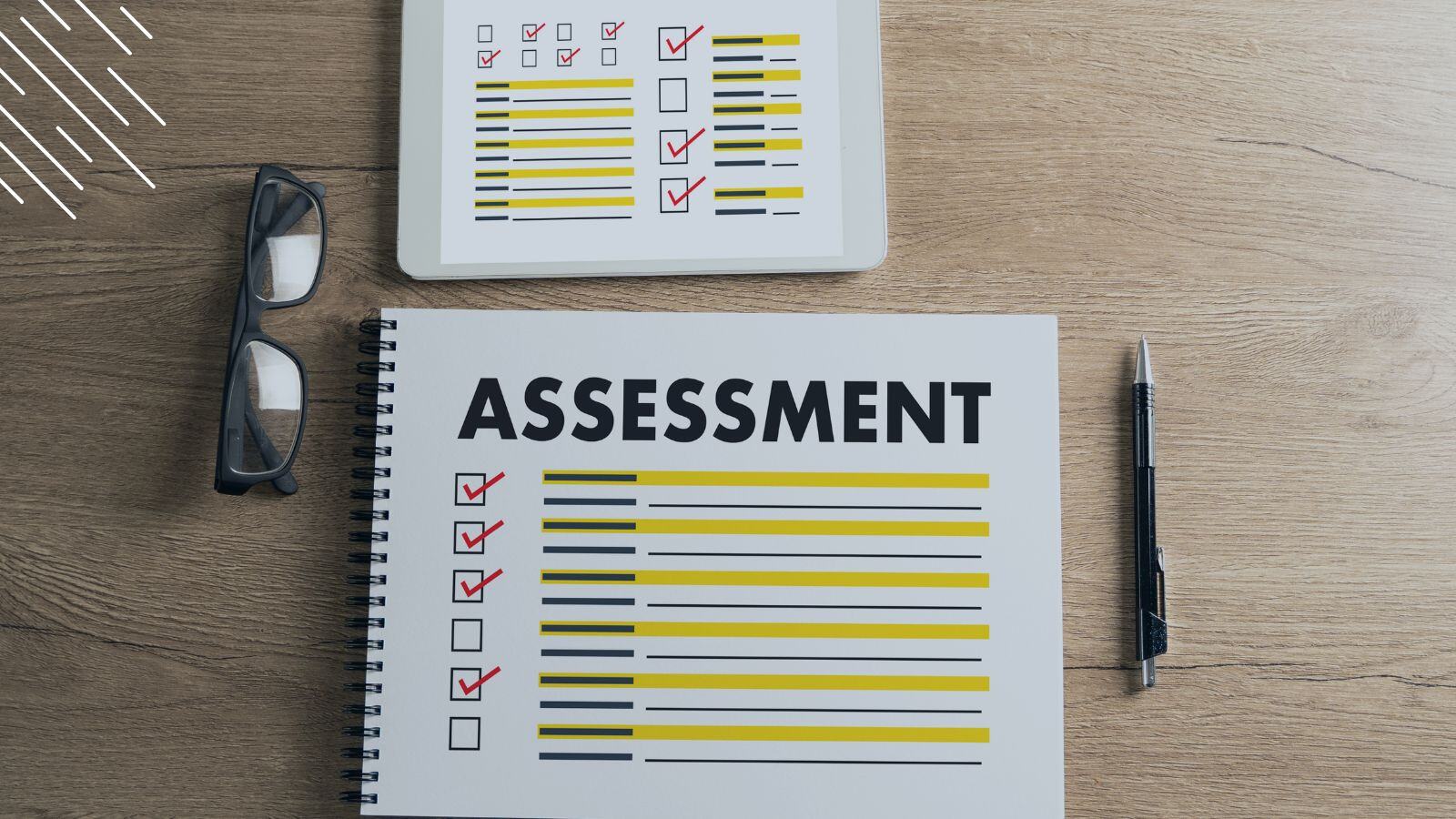.png?width=1920&height=1492&name=Juriba%20-%20Windows%2011%20Assessment%20Service%20(Hardware%20II).png)
On November 30th, 2021 Microsoft outlined its recommendations on how enterprises should move to Windows 11. In the document, the software giant states that "Windows 10 and Windows 11 are designed to coexist, so that you can use the same familiar tools and process to manage both operating systems. Using a single management infrastructure that supports common applications across both Windows 10 and Windows 11 helps to simplify the migration process. You can analyze endpoints, determine application compatibility, and manage Windows 11 deployments in the same way that you do with Windows 10."
As they have in the past, Microsoft is downplaying the obstacles enterprises will face during their migration, making it seem as if this can easily be run as yet another Business-as-Usual (BAU) stream which will cause very little disruption or none at all. We have spoken to a lot of customers and, interestingly, a large number of them who have not yet done further detailed investigations are expecting that this will be handled very much within their business as usual teams. A minority are still planning to do this as a dedicated project, albeit certainly with less effort and fewer resources than were required for Windows 7 and Windows 10.
So the question is: Should you really run your Windows 11 migration as a BAU or should you create a project with a dedicated budget and team for it? Today, I am going to take a closer look at the deciding factors before I go through a couple of scenarios. And, spoiler alert, the answer is (as it often is with these large IT Transformation projects) that it depends on the state of your desktop management environment.
The Deciding Factors
There are four deciding factors that determine whether you should run your Windows 11 migration as a full-blown project or you can go the BAU route:
- Your Past Evergreen IT Management Success & Internal Setup. The first factor is the degree of success you had in the past managing Windows 10 Servicing upgrades. This, of course, depends on whether or not you have adequate tooling to manage Evergreen IT management streams, if you have streamlined your processes to be highly automated, standardized processes, and how trained and skilled your team is in managing these.
- Percentage of devices that meet the Windows 11 hardware requirements. The second criteria concerns how many devices you have that meet the very strict Windows 11 hardware requirements. Preliminary data from our Windows 11 Assessment Service shows that 39% to 68% of devices in enterprise-size IT environments will have to be replaced before moving to Windows 11 because sometimes even the newly refreshed machines do not meet the stringent prerequisites. For most organizations, there will be some project-based elements, primarily around hardware replacement.
- How tightly are you managing your application portfolio and lifecycle? Luckily we are not seeing as many application compatibility issues this time. Nevertheless, there needs to be a proper focus on application management and any remediation of apps. We recommend smoke testing all of your applications automatically which will allow you to switch your devices to "green" (ready for migration) as fast as possible while minimizing any potential risks.
- Will you move to VDI and/or modernize your apps? Another big deciding factor is whether or not you are looking to change platforms or modernize your packaging formats as you move to Windows 11. This is something a lot of IT teams are considering at the moment. Obviously, if you are moving to a brand new infrastructure like Virtual Desktop Infrastructure (VDI), Azure Virtual Desktop (AVD), or Windows 365, we recommend running a project regardless of everything else as you suddenly have a lot more complexity to deal with that requires proper focus and management of tasks and deliverables.
If you do not know how many of your devices meet those requirements, we highly recommend that you run through the Juriba Windows 11 Assessment Service. The Bronze level (free for all current Juriba customers) will provide you with a detailed analysis within just a matter of a few days!
.png?width=1000&height=777&name=Juriba%20-%20Windows%2011%20Assessment%20Service%20(Hardware%20II).png)
Let's break it down into the different scenarios that highlight the different ends of the spectrum.
Best Case Scenario: You Routinely Upgrade To The Latest Windows 10, > 70% Of Your Devices Meet Win 11 Requirements, & You Will Be Lifting & Shifting Applications
Let's start with the ideal case scenario, but if you are not in this category, don't worry. Most organizations won't be. Ideally, you already are successfully using the right Evergreen IT Management tooling (e.g., Juriba Dashworks) in an industrialized, highly automated process that can migrate all in-scope users to a new OS as soon as possible — let's say in less than six months. Your team is highly trained in managing various streams of Evergreen IT Management and different BAU activities at the same time. In addition, you know that most of your devices (around 70%) meet the Windows 11 hardware requirements.
If this is you, congratulations! Your team is doing an amazing job and most likely can migrate to Windows 11 as part of your BAU project, but I cannot stress enough how crucial it is to
- Have the right tooling that allows your team to juggle thousands of dependencies while following a mathematically calculated migration path that provides you with maximum velocity (otherwise you end up with a huge mess) and
- Not underestimate the amount of work involved in replacing a larger number of devices than usual. Even if you're trying to do this in BAU, there is a lot of work around replacing a significant number of devices (quite difficult to do just in BAU) and it might need its own project. There is a big risk of potential business disruption and you might be better off managing the to-be-upgraded machines as a separate mini-project.
Worst Case Scenario: You Are Struggling To Manage Windows Upgrades, < 30% Of Your Devices Meet Win 11 Requirements, And/Or You Will Be Making Platform/Application Changes
If you have struggled in the past to keep pace with the bi-annual OS Servicing Channel upgrades, you probably do not have the right tooling and processes in place to orchestrate a constant flow of hundreds or even thousands of objects and dependencies. This alone would make me recommend taking your Windows 11 migration as an opportunity to get fully onboard with Evergreen IT by implementing the proper project management software, streamlining your processes, and training your staff accordingly.
But adding into the mix a hardware refresh, a potential platform change, and a move to Modern Apps, you will definitely need a dedicated project with its own budget and team members. However, be sure to integrate your BAU team from the start and always keep the long-term goal of continuous future management in mind so that when you hand it over, your organization is all set for BAU right away.
Most Organizations Will Fall Somewhere In The Middle
Most organizations will fall somewhere in between the best and worst cases. About one-third of enterprises will have their Windows Servicing somewhat nailed. They have the right tooling, a trained team, and streamlined processes, but they just found out that a large portion (more than half) of their devices does not meet the Windows 11 hardware requirements. Or they will lift and shift all of their applications, they have just finished a hardware refresh project and know that a lot of their machines are Windows 11 compatible, and they are not changing platforms, but their Evergreen IT Management / BAU execution needs work.
However, likelier than that are the enterprises that are stuck on Windows 10 1809/1909 or just stuck getting unstuck, are planning on migrating to Windows 11 while moving some users to VDI, and are modernizing a few hundred applications. These organizations probably assume that a lot of their hardware is compatible but they have not done any thorough analysis yet. We expect that a lot of large organizations fall into this category.
In this case, I very much recommend that you take advantage of our Windows 11 Assessment Service to get a crystal clear understanding of where you are. Within a matter of days, you can not only have your entire hardware inventory analyzed and know exactly how many and which of your applications are compatible but get your actual migrations completed. However, with having to manage this much change, you most likely will have to run a series of mini-projects or piggy-back them into one larger project.
Another in-between scenario is that some organizations will accept that their Windows 11 migrations will play out over a relatively long period of time. In this case, you can do a Business-as-Usual approach, but not only will you have to do the math to ensure without a doubt that you can migrate all of your business users in the 36-month support window — you will also need to be aware that as soon as you are done, you will have to start again and stick to the determined schedule! But if you had a time frame by which you absolutely must be finished, I would recommend that you do this as a dedicated project.
Conclusion
There is no right or wrong answer, but what is critical is that you put the right tooling in place to manage the migration in an accelerated fashion. If you haven't gotten your processes and your tooling 100% correct, then it will fail because it will just take forever and people will not have the right skills to actually manage it correctly through the process.
Barry is a co-founder of Juriba, where he works as CEO to drive the company strategy. He is an experienced End User Services executive that has helped manage thousands of users, computers, applications and mailboxes to their next IT platform. He has saved millions of dollars for internal departments and customers alike through product, project, process and service delivery efficiency.








![Windows 11 Enterprise Vs. Professional [A Comparison]](https://blog.juriba.com/hs-fs/hubfs/Windows%2011%20Enterprise%20Vs.%20Professional%20%5BA%20Comparison%5D.jpg?width=1600&height=900&name=Windows%2011%20Enterprise%20Vs.%20Professional%20%5BA%20Comparison%5D.jpg)














